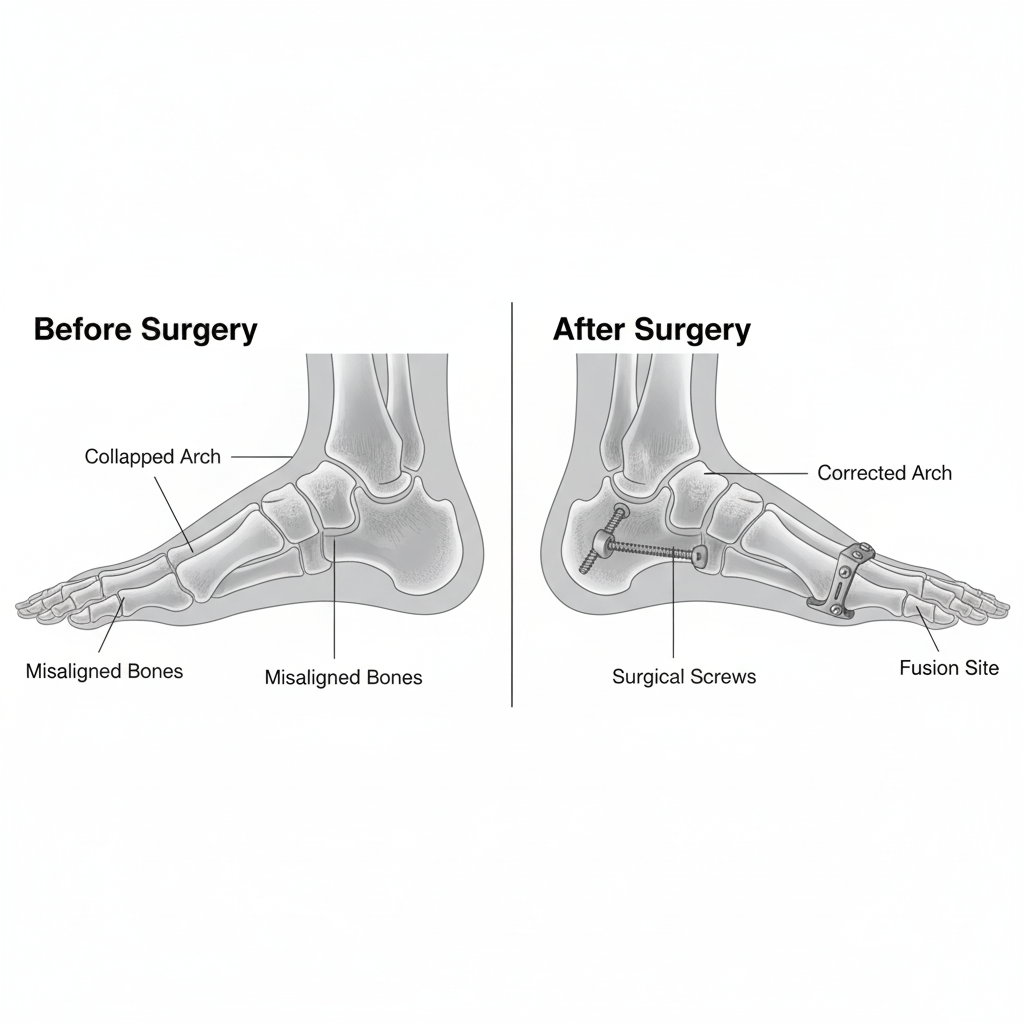Flatfoot Reconstructive Surgery
Restoring the Arch and Improving Foot Function
For individuals with a painful, progressive flatfoot deformity, reconstructive surgery can be a life-changing procedure. Adult-acquired flatfoot is often caused by the weakening or failure of the posterior tibial tendon, leading to a gradual collapse of the arch. This surgery is not a single procedure, but rather a combination of techniques tailored to the patient’s specific deformity, designed to relieve pain, restore the foot’s arch, and improve overall alignment and function.
At City Orthopaedics & Sports Medicine, our expert foot and ankle surgeons specialize in these complex reconstructions, creating a stable, supportive foundation to help you walk with comfort and confidence.
When is Flatfoot Surgery Necessary?
Surgery is typically recommended when the flatfoot deformity is both painful and progressive, and when conservative treatments are no longer providing adequate relief. You may be a candidate for surgery if:
- You experience chronic pain along the inside of your foot and ankle that limits your daily activities.
- Your arch is continuing to fall, and your foot is changing shape.
- Conservative treatments like custom orthotics, bracing, and physical therapy have failed to control your symptoms.
- The deformity is causing secondary issues, such as bunions, hammertoes, or pain in your knees and hips due to poor alignment.
The Goals of Flatfoot Reconstruction
The primary objectives of the surgery are to address both the pain and the underlying structural problem. The goals include:
- Relieving chronic pain from strained tendons and joints.
- Stopping the progression of the deformity.
- Recreating and stabilizing the arch of the foot.
- Improving the overall alignment between the foot, ankle, and leg.
- Enhancing walking ability and overall function.
Common Procedures in Flatfoot Reconstruction
Your surgeon will select a combination of procedures to address all aspects of your deformity. Common techniques include:
- Bone Cuts (Osteotomy): This is a foundational step. The heel bone is often surgically cut and shifted into a new, more stable position to correct the foot’s alignment. It is held in place with screws.
- Tendon Repair and Transfer: The diseased posterior tibial tendon is addressed. A nearby healthy tendon is often transferred to a new position to help support the arch and take over the function of the damaged tendon.
- Tendon Lengthening: A tight Achilles tendon is common with flatfoot. Lengthening this tendon is often necessary to allow the foot to be repositioned correctly.
- Joint Fusions (Arthrodesis): In cases with a severe, rigid deformity or arthritis, select joints in the midfoot or hindfoot may be fused together to provide permanent correction and stability.

What to Expect During Recovery
Recovering from flatfoot reconstruction is a lengthy process that requires a significant commitment to your surgeon’s protocol. Adherence to the recovery plan is critical for a successful outcome.
- Strict Non-Weight-Bearing: You will be required to keep all weight off your operated foot for an extended period, often 6 to 8 weeks or more. This will require the use of crutches, a walker, or a knee scooter.
- Immobilization: Your foot will be protected in a hard cast, which will later be transitioned to a removable walking boot.
- Pain and Swelling: Significant swelling is normal and can persist for many months. Your doctor will provide a plan to manage pain and swelling.
- Physical Therapy: Once the bones and tendons have healed sufficiently, you will begin a comprehensive physical therapy program to regain strength, flexibility, and balance, and to learn to walk on your newly reconstructed foot.
- Full Recovery: While you will be walking in a boot and then shoes over the first few months, it can take a full year to reach your maximum recovery and feel the final benefits of the surgery.
When faced with pain, injury, or discomfort in your foot or ankle, seeking a timely and precise diagnosis is essential. Dr. Jason Hymowitz, a distinguished board-certified foot and ankle surgeon, offers the expertise and compassionate care you need to move forward with confidence. Renowned for his skill in sports medicine, musculoskeletal deformities, and post-traumatic and cosmetic surgical reconstruction, Dr. Hymowitz blends advanced technology with evidence-based treatment to deliver exceptional outcomes. Whether through conservative care, minimally invasive techniques, or complex reconstructive surgery, he is dedicated to restoring your mobility, relieving your pain, and helping you return to the activities you love. Your path to lasting relief and improved quality of life begins with Dr. Hymowitz — a trusted expert committed to your well-being.


